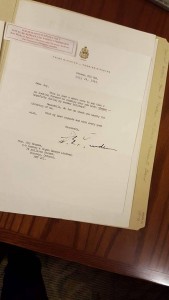Hey!
Last week, our class took a mini field trip to The Rare Books Library where we visited Joy Kogawa’s Fonds. We were able to look at a lot of her own personal things. These included fan letters, emails, rejection letters, multiple drafts, etc.
One of the things I focused on in the Fonds were the fan letters. I was surprised because of the large amount of letters from Japanese Canadians themselves. They enclosed letters about their families, their own personal struggles and the hardships their families went through. I spent most of the time in the Fonds reading and rereading the letters that people had written her because they mentioned how Joy Kogawa had helped them come to terms with their own personal histories.
In Obasan, Joy Kogawa talked about her family’s conflicts. She talked about her struggles, but also Obasan’s, Aunt Emily’s and even Steven’s. Despite this, the horror of the Japanese Internment didn’t seem as real to me as it did reading those letters last Thursday.
It reminded me that this was a National thing; that despite Canada’s reputation of being multicultural and accepting and nice, we weren’t always this way.
My grandparents immigrated here from Pakistan with my dad approximately 40 years ago, when my dad was only 5 months old. Despite my family being born there, I never went back to Pakistan to visit. To me, I was born Canadian and I would always be Canadian.
However, some Japanese Canadians, like Joy, were born in Canada too, but were still sent back to “their home country”.
I can only imagine how hard it would have been for them to live through that. Canada is my home, just as much as it was theirs. Canada was Joy’s home just as much as it was for the non-Japanese Canadians at that time.
Joy Kogawa’s Fonds helped me understand Obasan and her story a lot more than before. It demonstrated to me that this happened across the country and it was an absolutely terrible thing to happen.
Canada’s history is more than just hockey, gay marriage, and free healthcare. Canada’s history has been inexplicably racist at times.
However, I did also get a chance to skim through Pierre Trudeau’s letter to Joy Kogawa. In his letter he said he looked forward to reading Obasan. I’m glad to know that her history resonated with a Prime Minister, even if just for a little bit.
